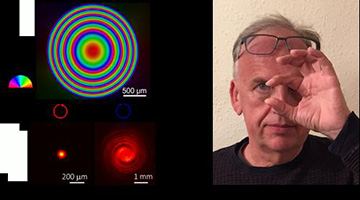
(Left) Birefringence image of a flat lens and intensity patterns of 488-nm laser beams with different handedness circular polarizations focused and defocused by the same lens. (Right) The same lens corrects short- and long-sightedness. [Image: Masaaki Sakakura, Yuhao Lei, Lei Wang, Yan-Hao Yu and Peter G. Kazansky]
Conventional optics control the wavefront by the thickness or refractive index of their constituent materials. A research team from the Optoelectronics Research Centre, University of Southampton, U.K., reports a laser-writing method in silica glass that could advance a promising new type of optics that exploits the geometric phase (GP) shift when a light wave is transformed by a different parameter, for example, polarization (Light Sci. Appl., doi: 10.1038/s41377-020-0250-y).
“Since the discovery of the laser, many studies have been carried out on the interaction of intense laser radiation with glass, which is a key material in modern optical technology,” says co-author Peter G. Kazansky. “Applications of glass span in the range from high-power lasers for laser fusion to optical waveguides for optical communication.” The new laser-writing technology, he says, could also be a breakthrough for high-capacity data storage in flat optical discs.
Fabricating polarization elements
Fabrication of polarization GP optical elements requires a method called birefringence patterning of the optical material. While these elements can be fabricated by photoalignment of liquid crystals, applications are limited by high absorption in the ultraviolet (UV) and infrared regions, and low chemical and thermal durability, the Southampton team writes. Another method is imprinting self-assembled nanograting structures in silica glass; however, optical loss due to light scattering by the nanostructures is a significant drawback.
The team—which also includes Masaaki Sakakura, Yuhao Lei, Lei Wang, and Yan-Hao Yu—thus tried a new type of femtosecond laser-induced birefringent modification. The researchers used the laser to induce randomly distributed nanopores in the silica glass elongated in the direction perpendicular to the polarization. The anisotropic nanopores, they write, are fundamentally different than the nanograting structures and represent a new type of material.
“During ultrafast laser direct writing, tight focusing of the beam in glass creates high intensity leading to multiphoton absorption, followed by avalanche ionization, and modification of the material,” Kazansky says. “A critical advantage of using femtosecond pulses,” he adds, “is that such pulses can rapidly and precisely deposit energy leading to material modifications confined to the focal volume.”
And while the exact mechanism of nanopore formation is not yet clear, Kazansky says, “defect formation, impact ionization, and high temperature in the irradiated region could be responsible.”
Low-loss patterning in glass heads to market
The researchers report that their femtosecond laser for birefringence patterning in silica glass provides ultra-low scattering loss with 99% transmission in the visible range and higher than 90% transmission in the UV spectral range down to 330 nm.
Low-loss modifications are crucial for achieving high-capacity polarization, multiplexed 5D optical memory in glass, Kazansky says. “Recording of thousands of layers of high transparent voxels,” he explains, “will enable reaching hundreds of terabytes per disc capacity.”
The technology has been licensed to a private company and the concept of 5D data storage in glass has been proven in a collaboration by the team with Microsoft, Kazansky says.
For full-scale commercialization of the technology, “the current main challenge is increasing the speed of writing,” Kazansky says, along with the high cost of ultrafast lasers. To meet those challenges, he says, will take about three to five years.
